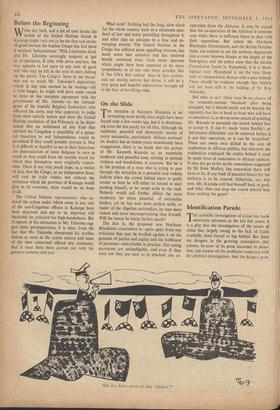Identification Parade
rrilE scientific investigation of crime has made I enormous advances in the last few years; it is a pity that the investigation of the causes of crime has, largely owing to the lack of funds available, been forced to lag behind. But there are dangers in the growing assumption that science, because of its great successes in detec- tion, can answer all the problems connected with the criminal investigation. And the dangers crow
'Say, Joe, how's about we play "chicken"?' when it is not so much science that is regarded as the cure-all, as pseudo-science. The 'breathalyser' fiasco is a case in point; and now we may have another in the Identi-kit.' The dreadful murder last week on the A6 has been followed by the police issuing two pictures, built up by this de- vice, of a man they think may be able to help in their inquiries. One of the pictures was made by the Identi-kit' with the aid of the injured woman in the case; the other by the same method from statements made by other witnesses. But the most brief examination of the two portraits shows scarcely a detail of the man's features common to both of them. Hair (style, colour and extent), mouth, chin, jaw, eyes, eyebrows, ears— the two pictures might be not only of two different men, but of two men totally dissimilar in appearance. • But what else can be expected? The fallibility of human memory, together with the impos- sibility of convincing most people of it, is one of the biggest handicaps to criminal investigation, and the `identi-kit' must depend, after all, on the memory of the witness being questioned. (There is a complicating factor here, of course; the woman was still gravely ill when she was questioned, which must understandably have affected her ability to remember exact details. But this might be regarded as an additional reason for the police to refrain from issuing the picture.) As a result, whether the man the police want to see is found or not, a number of men Who have no knowledge of the killing will be looked at askance by their neighbours and per- haps will be subjected to the unpleasant exper- ience of police questioning—if not of even more serious unpleasantness; and if the man is found, whatever the claims made, it seems hardly likely that it will be because two entirely different pic- tures of a man who may turn out to look like neither have been published in every newspaper in the land. Anything which helps to reduce crime without over-compensating harmful effects is to be welcomed; but we should not jump too readily at any fancy device which appears with a reputation and too little evidence to support it.



































 Previous page
Previous page